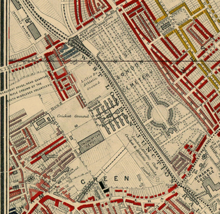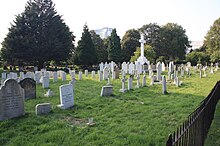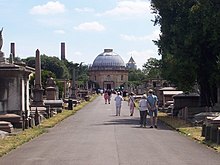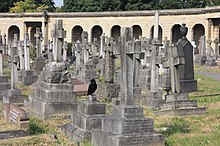Brompton Cemetery
Coordinates: 51°29′06″N 0°11′27″W / 51.4849°N 0.1908°W / 51.4849; -0.1908
 | |
| Details | |
|---|---|
| Established | 1839 |
| Location | London, SW10 |
| Country | England |
| Type | Public |
| Size | 39 acres (16 ha) |
No. of graves | 35,000+ |
No. of interments | 205,000 |
| Website | Official website |
Brompton Cemetery is a London cemetery in the Royal Borough of Kensington and Chelsea. It is managed by The Royal Parks, and is one of the Magnificent Seven cemeteries. Established by Act of Parliament and erected in 1839, it opened in 1840 and was originally known as the West of London and Westminster Cemetery.
Consecrated by Charles James Blomfield, the Bishop of London in June 1840, it is one of Britain's oldest and most distinguished garden cemeteries. Some 35,000 monuments, from simple headstones to substantial mausolea, mark the resting place of more than 205,000 burials. The site includes large plots for family mausolea, and common graves where coffins are piled deep into the earth, as well as a small columbarium. There is also a secluded Garden of Remembrance at the northern end, for cremated remains. It is also an urban haven for nature. It has been awarded a National Lottery grant to carry out essential restoration and develop a visitor centre among other improvements.
Contents
1 Location
2 History
3 Heritage status
4 Burials
4.1 Military graves
4.2 Notable interments
4.3 Exhumations
5 Funerary art
6 Flora and fauna
7 Public access
8 Trivia
9 Gallery
10 See also
11 References
12 Further reading
13 External links
Location

Charles Booth 1889 map – detail showing Brompton Cemetery
Brompton Cemetery is adjacent to West Brompton station in west London, England. The main entrance is at North Lodge, Old Brompton Road in West Brompton, SW5, in the Royal Borough of Kensington and Chelsea. There is another entrance at South Lodge, located on the Fulham Road, SW10 near the junction with Redcliffe Gardens.
History

Brompton Cemetery Chapel

Tomb of Frederick Richards Leyland (the only Grade II* funerary monument in Brompton Cemetery)

The military section, Brompton Cemetery

Main avenue

Outer east section, Brompton Cemetery

Colonnade, Brompton Cemetery, London

Central roundel, Brompton Cemetery

Emmeline Pankhurst's grave

angels, Brompton Cemetery

Monument of Valentine Cameron Prinsep

Grave of Nellie Farren
By the early years of the 19th century, inner city burial grounds, mostly churchyards, had long been unable to cope with the number of burials and were seen as a hazard to health and an undignified way to treat the dead. In 1837 a decision was made to lay out a new burial ground in Brompton, London. The moving spirit behind the project was the engineer, Stephen Geary, and it was necessary to form a company in order to get parliamentary permission to raise capital for the purpose. Securing the land – some 40 acres – from local landowner, Lord Kensington and the Equitable Gas Light Company, as well as raising the money proved an extended challenge.[1] The cemetery became one of seven large, new cemeteries founded by private companies in the mid-19th century (sometimes called the 'Magnificent Seven') forming a ring around the edge of London.
The site, previously market gardens, having been bought with the intervention of John Gunter of Fulham,[2] was 39 acres (160,000 m2) in area. Brompton Cemetery was eventually designed by architect, Benjamin Baud with at its centre a modest domed chapel dated 1839, in the style of the basilica of St. Peter's in Rome at it southern end, reached by long colonnades, and flanked by catacombs. It was intended to give the feel of a large open air cathedral. It is rectangular in shape with the north end pointing to the northwest and the south end to the southeast. It has a central "nave" which runs from Old Brompton Road towards the central colonnade and chapel.
Below the colonnades are catacombs which were originally conceived as a cheaper alternative burial to having a plot in the grounds of the cemetery. Unfortunately, the catacombs were not a success and only about 500 of the many thousands of places in them were sold. The Metropolitan Interments Act 1850 gave the government powers to purchase commercial cemeteries. The shareholders of the cemetery company were relieved to be able to sell their shares as the cost of building the cemetery had overrun and they had seen little return on their investment and there were few burials at first.
During World War II the cemetery suffered bomb damage.
Heritage status
The cemetery is listed Grade I in the English Heritage Register of Parks and Gardens of Special Historic Interest in England and five of the individual monuments are listed as Grade II.[3][4]Frederick Richards Leyland's is the only Grade II* listed funerary monument.
Burials
Brompton was closed to burials between 1952 and 1966, except for family interments, but is once again a working cemetery, with plots for interments and a 'Garden of Remembrance' for the deposit of cremated remains.[5] Many nationalities and faiths from across the world are represented in the Cemetery.
Military graves
From 1854 to 1939, Brompton Cemetery became the London District's Military Cemetery. The Royal Hospital Chelsea purchased a plot in the north west corner where they have a monument in the form of an obelisk; the Brigade of the Guards has its own section south of that. There are 289 Commonwealth service personnel of World War I and 79 of World War II, whose graves are registered and maintained by the Commonwealth War Graves Commission. A number of veterans are listed in the Notable Interments.[6] Although the majority of war graves are in the dedicated railed section to the west – also containing 19th century services graves – a number of servicemen's graves are scattered in other areas. Besides the British there are many notable Czekoslovak, Polish and Russian military burials.
Notable interments
Alexander Anderson – Royal Marines general
Tomasz Arciszewski – Polish socialist politician- Sir Frederick Arthur – army officer
James Atkinson – surgeon, artist and Persian scholar
William Edward Ayrton – physicist
Sir Squire Bancroft – actor and theatre impresario
Metropolitan Anthony (Bloom) of Sourozh – Russian Orthodox émigré Metropolitan archbishop, medical doctor and author
Joseph Bonomi the Younger – sculptor, artist, Egyptologist and museum curator
George Borrow – author, traveller and linguist
Peter Borthwick – politician
Sir Leslie Brass – lawyer and civil servant
Fanny Brawne – John Keats' muse, buried under her married name, Frances Lindon
Stanley Brett – actor
Eleanor Fortescue Brickdale (1871-1945) - painter and illustrator
Sir James Browne – engineer
Francis Trevelyan Buckland – zoologist- Field Marshal John Fox Burgoyne and his son, Hugh Burgoyne RN – Victoria Cross recipient
Henry James Byron – actor and dramatist- General William Martin Cafe – Indian Mutiny hero and VC recipient
Sir William Wellington Cairns – Australian administrator after whom the city of Cairns is named
Sir Duncan Cameron – British Army general- Louis Campbell-Johnston (1861–1929) – founder of the British Humane Association
- Marchesa Luisa Casati – infamous Italian quaintrelle, muse, eccentric and patron of the arts
John Graham Chambers – founder of the Amateur Athletic Association
Hugh Childers – Liberal statesman
Charles Coborn – music hall singer and comedian
Henry Cole – founder of the Victoria and Albert Museum, the Royal Albert Hall, the Royal College of Music, the 1851 Great Exhibition and inventor of the Christmas card
Robert Collier, 1st Baron Monkswell – Lord Monkswell, Privy Councillor, Attorney General for England and Wales, QC, politician and judge and his wife Isabella Rose
Robert Coombes – champion professional sculler
Joseph Thomas Clover – pioneer of anaesthesia
Hiram Codd – inventor of the Codd bottle
Thomas Crofton Croker – Irish antiquary, devoted to the collection of Irish poetry and folklore
William Crookes – chemist and physicist
Samuel Cunard – founder of the Cunard Line
Thomas Cundy III – architect
Agnes de Selincourt - missionary and academic- Sir James Bevan Edwards – army officer
- General Sir William Henry Elliott – army officer
- Corporal Joseph John Farmer – VC recipient
Nellie Farren – stage actress
Henry Farrer – artist
Terence Feely – playwright and author- Captain Alfred Kirke Ffrench – VC recipient of Indian Mutiny
- Lieutenant-General Sir Charles Craufurd Fraser – VC recipient
- Admiral Charles Fremantle – explorer, founded the Swan River Colony (Western Australia) and the city of Fremantle which bears his name
- Walter Forbes, 18th Lord Forbes
Robert Fortune – botanist who introduced tea plant from China to India
Sir John Fowler, 1st Baronet – railway engineer
Tom Foy – comedian
Princes George and Emanuel Galitzine – film producer and Spitfire pilot
Brian Glover (1934–1997) – television and film actor
John William Godward – painter
George Godwin – architect, journalist, and editor of The Builder magazine
George Goldie – "founded" Nigeria- Dr Benjamin Golding – founder of Charing Cross Hospital
- John Gunter – landowner, secured the south entrance to the cemetery
- Field Marshall Frederick Haines
Arthur Haliburton, 1st Baron Haliburton,[7] British civil servant- Corporal Thomas Hancock – VC recipient (unmarked grave)
- Sir Augustus Harris – actor
John Harrison – Royal Navy VC recipient
Thomas Helmore – choirmaster and author of books on plainsong- Admiral Algernon Heneage
Tim Hetherington – photojournalist
Rowley Hill – Bishop of Sodor- Sir Harold Hood, 2nd Baronet
- Colonel William Hope – VC recipient
Jean Ingelow – poet and novelist
John Jackson – boxer
Geraldine Jewsbury – writer
Michał Karaszewicz-Tokarzewski – founder of a Polish resistance unit in WWII and war hero
Mary Anne Keeley – actress
Robert Keeley – actor and comedian
William Claude Kirby – first chairman of Chelsea Football Club- Dr. Antoni Kutek – wartime medical officer of the MS Batory
Constant Lambert – composer and conductor
Kit Lambert – music producer and original manager of The Who
Percy E. Lambert – racing car driver
Nat Langham – middleweight bare-knuckle fighter- John Leslie-Melville, 9th Earl of Leven
Frederick Richards Leyland – shipowner and art collector
Bernard Levin – journalist, author and broadcaster
Sir John Scott Lillie – Peninsular War veteran, local landowner, inventor and social reformer
Ralph Robert Wheeler Lingen, 1st Baron Lingen (1819–1905)
Johann Carl Ludwig Loeffler – manager of Siemens Brothers
Marie Lohr – actress
Archibald Low – inventor and author of science books
David Lyon MP West Indies merchant, landowner and client of Decimus Burton
Wiktor Łomidze – Georgian-Polish Naval officer
James McDonald – president of the Anglo-American Oil Company
Henry McGee (1929–2006) – actor
John Benjamin Macneill – railway engineer- General Sir Frederick Francis Maude – VC recipient
Henry Augustus Mears – founder of Chelsea Football Club
Boyd Merriman, 1st Baron Merriman (1880–1962)
Lionel Monckton – composer of Edwardian musical comedies
Lieutenant-Colonel Hugh Montgomery – Royal Marines and intelligence officer, one of the IRA-assassinated Cairo Gang
Henrietta Moraes – writer, artist's model and muse to Francis Bacon
Roderick Murchison – geologist, originator of the Silurian system
Adelaide Neilson – actress
William Gustavus Nicholson, 1st Baron Nicholson – first Chief of the Imperial General Staff- Count Stanisław Julian Ostroróg – Crimean War veteran, photographer
Eugène Oudin – American baritone
Sydney Owenson, Lady Morgan – Anglo-Irish writer
Sir William Palliser – inventor and builder of Barons Court
Emmeline Pankhurst – leading suffragette- Private Samuel Parkes – VC recipient
Mrs Howard Paul – actress and singer
Charles Henry Pearson and his brother Sir John Pearson
Sir John Lysaght Pennefather – general
Henry Pettitt – actor, a noteworthy monument with a sculpted head of Pettitt
Percy Sinclair Pilcher – inventor and pioneering aviator
Valentine Cameron Prinsep – Pre-Raphaelite painter- Sir Robert Rawlinson – military officer
William Henry Macleod Read – political and social activist and merchant
Fanny Ronalds – American socialite and singer
William Michael Rooke – Irish composer
Blanche Roosevelt – American opera singer and author
Tim Rose – American singer-songwriter
Alexander Rotinoff – architect
William Howard Russell – journalist and war correspondent- Sir Doyle Money Shaw – naval officer
William Siborne – Army officer and military historian, maker of the Siborne model
Felicjan Slawoj Skladkowski – prime minister of Poland
Samuel Smiles – biographer and inventor of "self-help"
Albert Richard Smith – writer
John Snow – anaesthetist and epidemiologist, who demonstrated the link between cholera and infected water
Farren Soutar – musical comedy actor
Lord Alan Spencer-Churchill - officer 8th Hussars
General The Hon. Sir Augustus Almeric Spencer GCB - officer
H.F. Stephens – light railway pioneer
Robert Story – poet
Fred Sullivan, Thomas Sullivan and Mary Clementina Sullivan – brother, father and mother of Arthur Sullivan, composer
Jerzy Swirski – vice-admiral and head of the Polish navy, 1925–1947
Richard Tauber – operatic tenor
Sir David Tennant – Speaker of the Cape Parliament.
William Terriss - actor
Ernest Thesiger – character actor, The Old Dark House and Bride of Frankenstein
Frederic Thesiger, 1st Baron Chelmsford – jurist and statesman
Frederic Augustus Thesiger, 2nd Baron Chelmsford – Commander-in-Chief in the Zulu War
John Evan Thomas – sculptor
Brandon Thomas – author of Charley's Aunt
Stefan Tyszkiewicz – engineer, inventor, car manufacturer, political activist
Charles Blacker Vignoles – railway engineer, and inventor of the Vignoles rail- Colonel Richard Wadeson – VC recipient
Edward Wadsworth – artist
Thomas Attwood Walmisley – composer and organist.
Sir Robert Warburton – Anglo-Indian soldier and administrator
Jane Wardle - clinical psychologist and pioneer of cancer prevention- Flight Sub Lieutenant Reginald Alexander John Warneford – VC recipient
Sir Philip Watts – naval architect, designer of the Elswick cruiser and HMS Dreadnought
Sir Andrew Scott Waugh – army officer and surveyor, who named the highest mountain in the world after Sir George Everest
Benjamin Nottingham Webster – actor, theatre manager and playwright
Sir Thomas Spencer Wells – surgeon to Queen Victoria, medical professor and president of the Royal College of Surgeons of England- Private Francis Wheatley – VC recipient
Jack Whitley – professional footballer
Sir William Fenwick Williams – general, pasha and governor
John Wisden – cricketer and founder of Wisden Cricketers' Almanack
Bennet Woodcroft – textile manufacturer, industrial archaeologist, pioneer of marine propulsion, patent reformer and first clerk to the Patent Commissioners
Thomas Wright – antiquarian and writer
Johannes Zukertort aka Jan Hermann Zukertort – Polish-Jewish chess master
James Duffield Harding - Landscape painter, Lithographer and author
Exhumations
In the late 1880s when the nearby Earl's Court Exhibition Grounds played host to the American Show with Buffalo Bill, a number of First Nations American performers in the show, died while on tour in Britain. The Sioux chief, Long Wolf, a veteran of the Oglala Sioux wars was buried here on 13 June 1892 having died age 59 of bronchial pneumonia. He shared the grave with a 17-month-old Sioux girl named White Star believed to have fallen from her mother's arms while on horseback. 105 years later a British woman named Elizabeth Knight traced his family and campaigned with them to have his remains returned to the land of his birth.[8] In 1997, Chief Long Wolf was finally moved to a new plot in the Wolf Creek Cemetery (ancestral burial ground of the Oglala Sioux tribe) at Pine Ridge, South Dakota.
His great grandson John Black Feather said "Back then, they had burials at sea, they did ask his wife if she wanted to take him home and she figured that as soon as they hit the water they would throw him overboard, so that's why they left him here."[9][10][11]
There was a Brulé Sioux tribesman buried in Brompton named Paul Eagle Star. His plot was in the same section as Oglala Sioux warrior Surrounded By the Enemy who died in 1887 from a lung infection at age 22.[12] Like Long Wolf, he took part of Buffalo Bill's Wild West Show. Paul died a few days after breaking his ankle when he fell off a horse in August 1891. His casket was exhumed in spring of 1999 by his grandchildren, Moses and Lucy Eagle Star. The reburial took place in Rosebud's Lakota cemetery. Philip James accompanied the repatriation.
Little Chief and Good Robe's eighteen-month-old son, Red Penny who travelled in Buffalo Bill's Wild West Show is also buried here.[13] The resting places of both Surrounded and Red Penny remain a mystery.
Funerary art
The richness of the art and symbolism contained in many graves traces art movements across two centuries. Aside from the stonemason's and sculptor's craft, there is a vast array of lettering, decorative ironwork (sadly in a very corroded state) and ceramics. Some graves and mausolea are the work of noted artists and architects.
Flora and fauna
Although never envisaged as a park, JC Loudon devised the original planting scheme that was not fully realised. There are over 60 species of trees, of which the limes are dated to 1838. The fact of the enclosure of the cemetery by a wall, has preserved almost intact, a distinct area of Victorian country flora. Each season brings its features, like snow-drops and bluebells or wild lupin, broad-leaf pea and ferns. There are small scale wooded areas and meadows. Since the land was used for market gardens, there are wild cabbages, asparagus and garlic among the slabs. In Autumn, there can be a display of fungi, a mycologist's trove. The evergreens and ivy are a haven for birds and countless insects. Over 200 species of moth and butterfly have been identified in the cemetery. Mammals are represented by bats, a range of rodents, including grey squirrels and several families of foxes. Among the birds, there are many garden species with the addition of green woodpeckers and occasionally, kestrels. The macaws are only visitors.
Public access
The cemetery is open daily to the public throughout the year, with opening times varying with the seasons. It is regularly visited by the Parks Police Service to monitor and curb occurrences of anti-social behaviour.
Dog walking and cycling, under strict control, is permitted on indicated paths. Through traffic is forbidden and there is no parking. Any visiting vehicles must observe a 5 mph limit. The Bye laws are displayed on boards at both entrances.
The Friends of Brompton Cemetery organise Open Days, regular tours and other public attractions.[14]
Trivia

Nutkins gravestone
It was originally planned that Sir Arthur Sullivan of Gilbert and Sullivan fame would also be buried there with his family, until Queen Victoria insisted on his interment in St Paul's Cathedral.
Beatrix Potter, who lived in Old Brompton Road nearby and enjoyed walking around it, may have taken the names of some of her characters from tombstones in the cemetery. Names of people buried there included Mr. Nutkins, Mr. McGregor, Mr. Brock, Mr. Tod, Jeremiah Fisher and even a Peter Rabbett, although it is not known for certain if there were tombstones with these names.[15][16][17]
The cemetery has a reputation for being a popular cruising ground for gay men.[18]
Brompton Cemetery has featured in a number of films, including as the exterior of a Russian church in Goldeneye,[19]Stormbreaker, Johnny English [19] and The Wings of the Dove.[20]
Gallery
Old Brompton Road entrance

001-brompton-cemetery-by William Cowen

Among the gravestones
Monument to John Snow
The lion on the grave of "Gentleman" John Jackson
Monument to Robert Coombes (on the right, now sadly defaced)

Monument to Gus Mears, founder of Chelsea F.C. nearby
Brompton Cemetery bas-relief
Entry to the catacombs
Chelsea Pensioners' Memorial
mausoleum, Brompton Cemetery
Central section

Blue visitor among Gravestones
Brompton Cemetery SE Arcade

Fulham Road entrance (1873)
Brompton Cemetery near Stamford Bridge stadium
portal, Brompton Cemetery
Central avenue, Brompton Cemetery

Middlesex, detail of Fulham c.1860
See also
- Magnificent Seven cemeteries
- Funerary art
- London Cemetery and Extension
- Victorian cemetery
- Commonwealth War Graves Commission
References
^ Sheppard, F.H.W., ed. (1983). "Brompton". Survey of London. 41. London: London City Council. pp. 246–252. Retrieved 24 June 2018..mw-parser-output cite.citationfont-style:inherit.mw-parser-output .citation qquotes:"""""""'""'".mw-parser-output .citation .cs1-lock-free abackground:url("//upload.wikimedia.org/wikipedia/commons/thumb/6/65/Lock-green.svg/9px-Lock-green.svg.png")no-repeat;background-position:right .1em center.mw-parser-output .citation .cs1-lock-limited a,.mw-parser-output .citation .cs1-lock-registration abackground:url("//upload.wikimedia.org/wikipedia/commons/thumb/d/d6/Lock-gray-alt-2.svg/9px-Lock-gray-alt-2.svg.png")no-repeat;background-position:right .1em center.mw-parser-output .citation .cs1-lock-subscription abackground:url("//upload.wikimedia.org/wikipedia/commons/thumb/a/aa/Lock-red-alt-2.svg/9px-Lock-red-alt-2.svg.png")no-repeat;background-position:right .1em center.mw-parser-output .cs1-subscription,.mw-parser-output .cs1-registrationcolor:#555.mw-parser-output .cs1-subscription span,.mw-parser-output .cs1-registration spanborder-bottom:1px dotted;cursor:help.mw-parser-output .cs1-ws-icon abackground:url("//upload.wikimedia.org/wikipedia/commons/thumb/4/4c/Wikisource-logo.svg/12px-Wikisource-logo.svg.png")no-repeat;background-position:right .1em center.mw-parser-output code.cs1-codecolor:inherit;background:inherit;border:inherit;padding:inherit.mw-parser-output .cs1-hidden-errordisplay:none;font-size:100%.mw-parser-output .cs1-visible-errorfont-size:100%.mw-parser-output .cs1-maintdisplay:none;color:#33aa33;margin-left:0.3em.mw-parser-output .cs1-subscription,.mw-parser-output .cs1-registration,.mw-parser-output .cs1-formatfont-size:95%.mw-parser-output .cs1-kern-left,.mw-parser-output .cs1-kern-wl-leftpadding-left:0.2em.mw-parser-output .cs1-kern-right,.mw-parser-output .cs1-kern-wl-rightpadding-right:0.2em
^ "Kensington and Chelsea Brompton Cemetery Conservation Area Proposals Statement" (PDF). Royal Borough Kensington and Chelsea. Retrieved 24 June 2018.
^ Leaflet entitled "Brompton Cemetery" issued by the Friends of Brompton Cemetery
^ Historic England, "Brompton Cemetery (1000248)", National Heritage List for England, retrieved 10 February 2016
^ "Brompton Cemetery". Brompton-cemetery.org. Retrieved 2013-12-07.
^ r. "Cemetery Details". CWGC. Retrieved 2013-12-07.
^ Atlay, James Beresford (1912). . In Lee, Sidney. Dictionary of National Biography, 1912 supplement. London: Smith, Elder & Co. p. 186.
Atlay, James Beresford (1912). . In Lee, Sidney. Dictionary of National Biography, 1912 supplement. London: Smith, Elder & Co. p. 186.
^ Balz, Dan (26 September 1997). "Chief Long Wolf's Last Journey". Washington Post. ISSN 0190-8286. Retrieved 25 June 2018.
^ "Brompton Cemetery". BBC. 9 April 2008. Retrieved 1 March 2010.
^ "Chief Long Wolf goes home, 105 years late". CNN. 25 September 1997. Archived from the original on 19 April 2010. Retrieved 1 March 2010.
^ Weaver, Maurice (5 May 1997). "Sioux reclaim tribal chief from English grave". The Daily Telegraph. London. Archived from the original on 26 September 2005. Retrieved 1 March 2010.
^ "Sioux mystery solved". Manchester Evening News. 3 October 2007. Retrieved 25 June 2018.
^ "The Salford Sioux – Manchester's own native American community (Lancashire) Page 4 RootsChat.Com".
^ "The Friends of Brompton Cemetery". The Friends of Brompton Cemetery.
^ Barden, Karen (3 August 2001). "Grave inspiration to Beatrix Potter". The Westmorland Gazette. Newsquest (North West) Ltd. Retrieved 26 May 2013.
^ Baker, Erin (28 July 2001). "Beatrix Potter's cast list found on headstones". The Telegraph. London: Telegraph Media Group Limited. Retrieved 25 May 2013.
^ Mason, M. (2013). Walk the Lines: The London Underground, Overground. London: Arrow Books. p.174
ISBN 978-0-099-55793-7
^ "Go west, young man" (PDF). QX Magazine International. Retrieved 21 April 2011.
^ ab Smith, Oliver (4 October 2017). "The London filming locations you might not have known about". The Telegraph. Retrieved 25 June 2018.
^ "Brompton Cemetery in film". The Royal Parks. Retrieved 25 June 2018.
Further reading
- Meller, Hugh & Brian Parsons, London Cemeteries: an illustrated guide and gazetteer, The History Press, 2008,
ISBN 978-0-7509-4622-3. - Beach, Darren, London's Cemeteries, Metro Guides, 2006,
ISBN 1-902910-23-0 - Culbertson, Judi & Tom Randall, Permanent Londoners: An Illustrated Guide to the Cemeteries of London. Post Mills, VT: Chelsea Green Publishing Company, 1991.
External links
| Wikimedia Commons has media related to Brompton Cemetery. |
- Friends of Brompton Cemetery
Brompton Cemetery (Royal Parks website)- Recent photos and information on Brompton Cemetery
- YouTube – Brompton Cemetery – Guided Tour – Introductory Talk
- Brompton Cemetery. List of notable occupants.




















